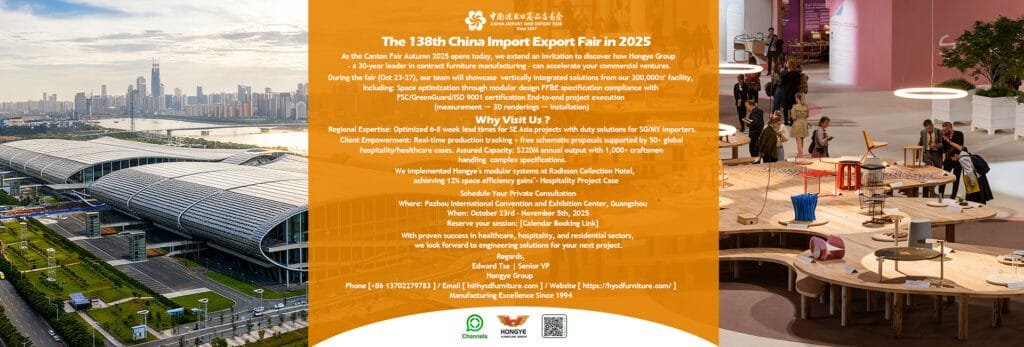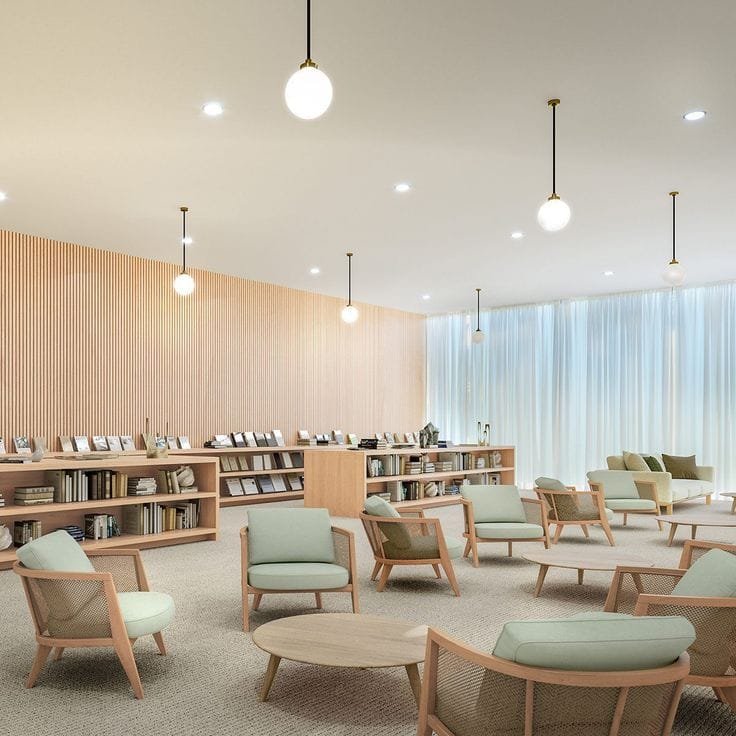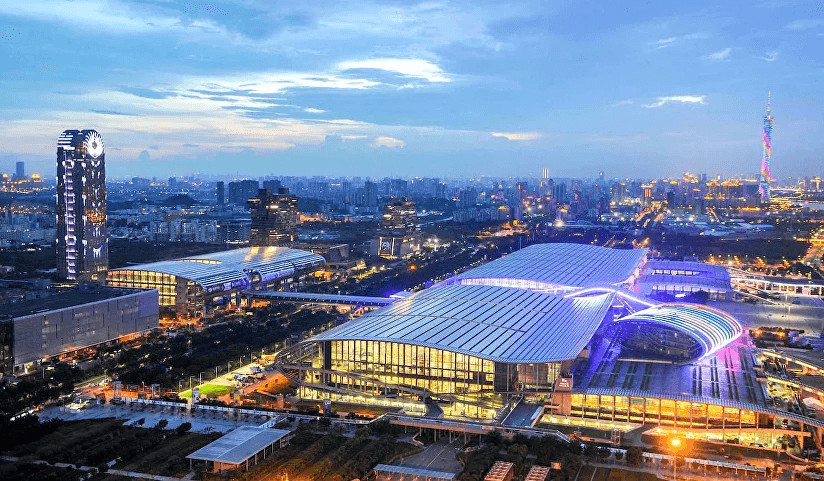The global commercial furniture market is experiencing significant growth driven by innovation, sustainability, and evolving business requirements. The Canton Fair stands as the world’s premier sourcing platform for commercial furniture meeting these demands. For commercial buyers, hotel owners, importers, and designers, the 2025 edition offers unprecedented opportunities to access manufacturers pioneering smart furniture, sustainable solutions, and modular systems. This guide examines market trends, hospitality growth opportunities, sourcing strategies, and case studies enabling you to maximize Canton Fair investments and establish supplier relationships delivering competitive advantages.

Commercial Furniture Market Overview 2025
The commercial furniture market demonstrates robust expansion across all segments. Hotel and hospitality furniture experiences accelerated growth driven by tourism recovery and boutique hotel proliferation. Contract furniture—designed for commercial durability and maintenance efficiency—commands premium pricing justified by extended lifecycle performance.
Key Market Drivers:
- Hybrid work arrangements requiring flexible office configurations
- Hotel design differentiation driving premium furniture investments
- Healthcare expansion creating substantial procurement opportunities
- Corporate sustainability commitments driving eco-friendly demand
- Cost optimization through modular, future-proof solutions
China maintains manufacturing dominance through infrastructure, skilled labor, and production scale. Guangdong concentrates specialized manufacturers—Foshan for upholstered seating, Shunde for modular systems, Dongguan for smart furniture electronics integration.
Buyer Demographics vary significantly. Large hotel chains prioritize brand standard compliance and cost efficiency. Boutique hotels emphasize design differentiation. Importers require diverse product portfolios with customization flexibility. Each segment demands different supplier capabilities and negotiation approaches.
| Market Segment | Growth Rate | Key Characteristics | Primary Buyers |
|---|---|---|---|
| Corporate Office | 6-8% | Ergonomic focus, technology integration | Facility managers |
| Hotel & Hospitality | 8-11% | Design differentiation, durability | Hotel owners, developers |
| Healthcare | 7-9% | Compliance, infection control | Healthcare administrators |
| Restaurant | 5-7% | High-traffic durability, maintenance ease | Restaurant owners |
| Educational | 4-6% | Budget efficiency, multi-function | School administrators |
Emerging Trends: Smart, Sustainable & Modular Solutions

Smart furniture incorporates IoT capabilities and sensing technologies transforming static furnishings into responsive workspace elements. Conference tables integrate wireless charging and cable management. Hotel guest rooms feature USB charging and voice-activated controls. Workspace analytics track utilization patterns enabling space optimization. Implementation considerations include power infrastructure requirements, technology obsolescence planning, and maintenance complexity.
Sustainable materials reflect fundamental procurement requirements. Recycled ocean plastic upholstery, bamboo materials, and bio-based foams reduce environmental impact. Water-based finishes eliminate volatile organic compounds. Solar-powered manufacturing reduces carbon footprints. Durability represents sustainability’s fundamental dimension—furniture serving fifteen to twenty years delivers superior environmental performance regardless of material composition.
Modular design systems address evolving business needs through reconfigurable components. Hotels reconfigure lobby furniture for different events. Offices adjust layouts supporting reorganizations without complete replacement. Modular systems simplify future expansion, enable targeted component replacement, and maintain visual cohesion across configurations.
| Innovation | Benefits | Implementation Considerations | Typical Premium |
|---|---|---|---|
| Smart Technology | Space optimization, energy efficiency, analytics | Power infrastructure, tech obsolescence | 25-40% |
| Sustainable Materials | Environmental compliance, brand alignment | Material durability verification | 15-30% |
| Modular Design | Flexibility, future-proofing, maintenance simplicity | Connection system quality, aesthetics | 20-35% |
Hotel & Hospitality Sector Growth Opportunities
Boutique hotels proliferate as travelers seek distinctive experiences. Furniture procurement emphasizes originality over cost efficiency, with owners investing in bespoke pieces creating memorable guest impressions. Manufacturing partners serving boutique properties require design flexibility, custom production capabilities, and commercial-grade construction.
Brand standard compliance programs balance design with operational efficiency. Corporate specifications define furniture across hundreds of properties, enabling economies of scale. Manufacturers serving franchise systems require production capacity supporting large simultaneous orders, inventory management enabling phased deliveries, and quality consistency across extended production runs.
Restaurant furniture endures intensive daily use, frequent commercial chemical cleaning, and continuous repositioning. Commercial-grade construction, stain-resistant upholstery, and moisture-resistant materials distinguish successful restaurant furniture. Diverse concepts demand varied solutions—fine dining requires upscale aesthetics; quick-service prioritizes durability and cost efficiency; outdoor areas need weather resistance.
Senior living and healthcare hospitality combine residential comfort with healthcare functionality. Furniture accommodates mobility limitations, supports safe patient handling, facilitates cleaning and infection control, and creates welcoming environments. Specialized requirements include enhanced weight capacity, armrest designs assisting standing from seated positions, and materials tolerating frequent disinfection.
Global Sourcing Strategy: Canton Fair Edition

Pre-Fair Preparation begins weeks ahead. Define comprehensive requirements including specifications, quality standards, volumes, and budgets. Develop target supplier lists using the Canton Fair’s exhibitor directory, focusing on manufacturers with relevant products, export experience, and appropriate scales. Research suppliers through trade databases, websites, and industry contacts. Prepare professional company materials including translated business cards.
On-Site Evaluation demands efficient supplier assessment. Dedicate initial time to comprehensive reconnaissance without premature commitments. Distinguish manufacturers from trading intermediaries by requesting specific production information and proposing factory visits. Evaluate quality through hands-on testing—sit in chairs, operate drawers, examine construction. Request certifications including fire safety ratings and environmental compliance documentation.
Negotiation Strategy emphasizes comprehensive value rather than price alone. Demonstrate genuine intent through detailed requirement discussions. Request itemized quotations detailing all charges. Emphasize potential for long-term relationships. Structure initial trial orders scaling to regular replenishment upon successful quality verification. Formalize agreements through comprehensive purchase contracts.
Quality Assurance protects investments. Approve pre-production samples incorporating specified materials, finishes, and dimensions. Conduct factory inspections observing production capabilities and quality systems. Engage independent third-party inspections at 80-100% production completion. Verify compliance with destination market requirements.
| Sourcing Stage | Key Activities | Critical Success Factors | Pitfalls to Avoid |
|---|---|---|---|
| Pre-Fair | Research, specification definition, materials prep | Comprehensive specs, realistic budgets, professional presentation | Inadequate research, vague requirements |
| Evaluation | Booth visits, quality assessment, verification | Physical testing, factory visits, certification review | Trusting appearances, skipping due diligence |
| Negotiation | Pricing, terms, relationship building | Comprehensive value focus, fair expectations | Price-only focus, unrealistic demands |
| Quality Assurance | Sample approval, inspection, verification | Detailed documentation, independent verification | Skipping samples, avoiding inspections |
Conclusion
Commercial furniture market expansion creates opportunities for strategic buyers approaching procurement systematically. Market trends—smart technology, sustainability, modular flexibility—position organizations for forward-looking investments. Hotel and hospitality sector growth generates ongoing opportunities for manufacturers combining design creativity with operational durability.
Canton Fair represents the premier sourcing platform, but success requires comprehensive pre-fair preparation, systematic evaluation, skilled negotiation balancing cost and quality, rigorous quality assurance, and professional relationship management. Successful projects share characteristics: clear requirements, thorough supplier evaluation, comprehensive quality assurance, and collaborative problem-solving.
Approach Canton Fair sourcing as strategic relationship investment rather than one-time transaction. Quality partnerships delivering consistent products, reliable service, and collaborative innovation represent commercial furniture procurement’s ultimate objectives, delivering value extending well beyond initial orders.
Frequently Asked Questions
What distinguishes commercial-grade furniture from residential furniture?
Commercial-grade furniture features reinforced construction and mechanisms rated for 100,000+ operational cycles versus 15,000-30,000 for residential. Upholstery meets higher durability standards. These distinctions critically impact total cost of ownership—residential furniture typically fails within 2-3 years of commercial use, while commercial furniture serves 10-15 years, delivering superior long-term value despite higher initial investment.
How should buyers evaluate manufacturers’ sustainability claims?
Verify claims through third-party certifications: Forest Stewardship Council confirms responsible forestry; Cradle to Cradle evaluates lifecycle impacts; GREENGUARD certifies low emissions. Request Environmental Product Declarations providing transparent assessments. Examine manufacturing practices through factory visits. Evaluate durability as fundamental sustainability—furniture serving twice as long delivers approximately half the environmental impact per year regardless of material composition.
What minimum order quantities should buyers expect?
Standard products may accept 20-40 units per container. Custom products typically require 100-200 pieces justifying specialized tooling. Some manufacturers offer mixed containers enabling multiple products reaching minimums without excessive single-item quantities. Negotiate reduced-quantity trial orders at higher per-unit costs demonstrating quality verification intent before standard minimums.
How do smart furniture technologies impact long-term costs?
Smart features require evaluating both benefits and maintenance implications. Technology introduces power dependencies, software updates, component obsolescence, and specialized repair requirements. However, properly implemented features deliver measurable benefits—workspace analytics optimize space planning; automated controls improve energy efficiency; user experience enhancements support productivity. Calculate whether benefits justify complexity and technology refresh cycles typically requiring 3-7 year replacement.
What warranty terms should buyers negotiate?
Standard warranties range 3-10 years depending on categories—5-7 years for upholstered seating, 7-10 years for wood casegoods, 3-5 years for metal. Warranties should explicitly define structural failures versus normal wear. Negotiate extended terms for large commitments. Clarify claim procedures, response timelines, and resolution methods. Verify replacement part availability throughout expected 15-20 year lifecycles. Document terms explicitly in purchase agreements.
How can buyers protect intellectual property with Chinese manufacturers?
Include explicit IP provisions in agreements specifying design ownership, manufacturing exclusivity, confidentiality requirements, and remedies for violations. Register designs through Chinese IP authorities—China uses first-to-file systems making registration essential. Work with established manufacturers having reputations protecting. Consider production splitting for sensitive designs, preventing single-factory control. Maintain detailed design development documentation establishing clear ownership timelines.


